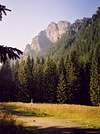-
 9032 Hits
9032 Hits
-
 87.31% Score
87.31% Score
-
 24 Votes
24 Votes
|
|
Mountain/Rock |
|---|---|
|
|
49.19343°N / 20.10117°E |
|
|
7119 ft / 2170 m |
|
|
Intro
Mlynar, Mlynarz, Muller, Molnar, Miller 2170 Legendary peak in the very heart of High Tatras rising above the central part of Belovodska Valley system Wonderful nature and gooorgeous summit panorama. The most impressive view of Mlynar one can admire from the bottom of Belovodska Valley where the peak sends its incredible vertical eastern cliffs what makes the whole area one of the most picturesque places in Tatra Mountains. Among others imposing 300 metre vertical, granite cliff of Mlynarczyk(POL). The favourite hunting area for huntsmen in 19th century. A beatiful folk legend explains the origin of the name of the peak (full version coming soon!) which comes from the shape of rocks in the eastern ridge reminding a figure of a millerman hammering or carrying a millstone. The hole in the millstone, in the Przeziorowa Turnia(POL) ridge can be well seen from the trail in Belovodska Valley. First known tourist ascent : between 1881 and 1885 - Ludwik Chalubinski and guides: Wojciech Bukowski and Jan Gronikowski It is rather sure that the summit was visited earlier by huntsmen . First winter ascent : 4.II.1914 - Jozef Lesiecki and Jozef OppenheimMlynar (2170)
Mlynar(2170) massif rises above valleys of : Zabia Bialcanska, Ceska and the main branch of Belovodska in a lateral ridge outgoing east from Vysny Zabi Stit(2259) peak. The structure of the massif is strikingly complicated due to a large number of side ridges full of prominent crags sent in almost all directions. The long northern Mlynar ridge is formed by numerous more and less prominent rocky culminations and passes(among others : Maly Mlynar(1975) and Prostredny Mlynar). The closing section of the ridge behind the wide pass of Sedlo za Skorusniakom is so called Skorusniak(1804) The impressive eastern ridge is much shorter ending in Mlynarczyk crag undercut by 300 metre vertical cliff.Getting There
You can visit the area both from Slovak and Polish side of the mountains. The key thing when planning a stay in Slovak High Tatra is to get to Poprad - major city in the area with very good communication links with the rest of the country, from there You should go to one of close High Tatra resorts: Stary Smokovec or Strbske Pleso for example. You can find accomodation anywhere in the area, thanks to electric train line you will find yourself anywhere you want at the right time. Numerous bus connections to Lysa Polana (Polish/Slovak bordercrossing point) where the trail to Belovodska Valley (Mlynar Peak area) starts its run. Slovak bus and train connection search On Polish side as usual you must get to Zakopane first, very well developed bus and train communication with the whole Poland, especially nearby Cracow City (100 km). Everyone who'd like to visit Mlynar peak and the whole gorgeous Bielovodska valley area should take one of many buses or minibuses going in the direction to Palenica Bialczanska("Morskie Oko") and get off one stop before the final one at Lysa Polana - former Polish/Slovak road bordercrossing point. No more than 100 metres further behind the building a long trail to Belovodska Valley starts its run. PKS Cracow – Zakopane bus departures PKP - Polish Railways connection search PKS Zakopane - buses The nearest airports to Tatra mountains are located in Cracow(100 km)in Poland and in Poprad nearby in Slovakia. Cracow Airport Poprad-Tatry Airport
Red Tape
It is Tatra National Park(TANAP) area, there are no entry fees but You can hike using only marked trails. Watch out for strict rules of wildlife conservation. Stay always respectful to mountain nature! The whole Mlynar massif is an area of strict natural reservation. From 1.11 to 15.06 year by year all marked routes in TANAP(the whole Slovak side of Tatras) are being closed for tourists (besides the routes leading to mountain chalets). On 21.12.2007 Slovakia along with Poland signed Schengen Agreement and accessed to "open borders" Schengen Area,however one must remember that National Park regulations prohibiting crossing the border beside marked trails in the whole area remain in force.

















